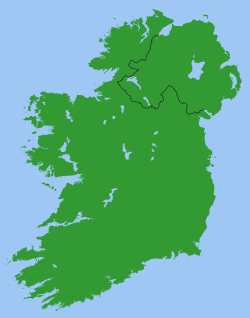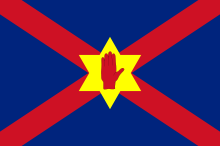Repartition of Ireland
The repartition of Ireland has been suggested as a possible solution to the continuing political disagreement in Northern Ireland. It implies that the essential problem was that the partition of Ireland was gerrymandered, and as a result Northern Ireland contains a large Irish nationalist minority. Much of the Irish nationalist population lives in the south and west of the region, but a significant percentage lives in Belfast and some smaller communities in the north and east, whilst British unionists constitute a majority of the population in the north and east of the region with some smaller communities in the south and west. The geographical area in which unionists are a majority is less than half of Northern Ireland (see graphic below), but eastern areas have a much higher population density. Collectively, Northern Ireland is split, with unionists comprising approximately 50% of the population, and falling slowly. At the last general election unionists secured precisely 50% of the seats.[1] None of these proposals are currently supported by any political party in Ireland.[2]

1920 to 1969
The idea was first mooted at the time the border was drawn up. Some Irish republicans, including Cahir Healy, while objecting to the partition in principle, argued in particular that County Fermanagh and County Tyrone should not be included in what became Northern Ireland, as they had a majority nationalist population. John Redmond also indicated that he would be prepared to accept this option.
The Boundary Commission determined the current border in 1925, although the Irish Free State delegate (Professor Eoin MacNeill) had resigned in protest at its failure to respect the terms of the Treaty.[3] Its decision was not published. The three governments, however, determined another agreement on 6 December 1925 (subject to parliamentary approval) which confirmed the existing boundary of Northern Ireland, along with other matters.[4] This new agreement was approved by the Dáil (the lower house of the Free State parliament) by a vote of 71 to 20.[5]
1969 to 1980
.jpg)
Repartition resurfaced as an option with the start of the Troubles. In 1972, the Conservative MP Julian Critchley published a pamphlet for the Bow Group advocating repartition, titled Ireland: A New Partition. Civil servants in London prepared a "last-ditch" plan in 1974, for possible use in the event of a full-scale civil war which would see Roman Catholic inhabitants of the northeast forcibly moved to Fermanagh, Southern Londonderry, Tyrone, South Armagh and South Down. Protestant inhabitants in those areas would be moved into North Down, Antrim, Northern Londonderry, and North Armagh. The nationalist areas would then be ceded to the Republic of Ireland. An alternative plan simply involved "moving individual Catholics from their homes in Northern Ireland to new homes in the Republic". The plan was kept secret at the time and was revealed in 2002.[6][7] In a 2006 essay, Garret FitzGerald, the Republic's Foreign Minister in 1974, revealed his government's opinions on repartition or a complete British withdrawal.[8]
1980 to 1998
Pollsters have rarely asked the population of Northern Ireland about their attitudes to repartition but it was asked twice in the early 1980s. In June 1981 and February 1982 the percentages of Protestants agreeing to repartition was 9% and 8%; the percentages for Catholics were 22% and 24%.[9]
Research by Paul Compton of Queen's University of Belfast (QUB) fed into a secret 1984 briefing paper prepared by the Northern Ireland Office for then-Prime Minister Margaret Thatcher, which examined various repartition schemes, the most extensive transferring to the Republic half of Northern Ireland's territory and one-third of its population, with West Belfast a "walled ghetto" enclave.[10] The plans were quickly dismissed as impractical and politically unworkable.[10] Later in 1984, then-Taoisaeach Garret FitzGerald spoke against repartition as reinforcing partition.[10]
In 1986, QUB economic historian Liam Kennedy published a book-length study of repartition called Two Ulsters: A Case for Repartition.
During the late 1980s, repartition was repeatedly proposed by assorted individuals and small groups. It became popular in some sections of the Ulster nationalist movement, who were keen to establish a state with a large Protestant majority. Conversely, the Ulster Movement for Self-Determination proposed an enlarged state of Ulster, including all the historic province. This state, were it to have been created, would have had almost equal numbers of nationalists and unionists.
In early January 1994, the Ulster Defence Association (UDA) released a document calling for repartition combined with ethnic cleansing, with the goal of making Northern Ireland wholly Protestant.[11] The plan was to be implemented should the British Army withdraw from Northern Ireland. The vastly Irish Catholic and nationalist areas would be handed over to the Republic, and those left stranded in the "Protestant state" would be "expelled, nullified, or interned".[11] The story was printed in The Sunday Independent newspaper on 16 January.[12] The "doomsday plan" was based on the work of Liam Kennedy, though he had not proposed ethnic cleansing.
Margaret Thatcher said in 1998 that when it became obvious that the Anglo-Irish Agreement was in trouble, she too had considered repartition, although again she had not pursued the scheme.[13]
Notes
- ↑ Elections in Northern Ireland
- ↑ "CAIN: An Outline of the Main Political 'Solutions' to the Conflict". Cain.ulst.ac.uk. Retrieved 2011-07-14.
- ↑ Dáil Éireann - Volume 13 - 24 November 1925: THE BOUNDARY COMMISSION Historical debates of Dáil Éireann, November 1925
- ↑ Dáil Éireann - Volume 13 - 7 December 1925: TREATY (CONFIRMATION OF AMENDING AGREEMENT) BILL, 1925. Line 1300
- ↑ Dáil Éireann - Volume 13 - 10 December 1925: PRIVATE BUSINESS. - TREATY (CONFIRMATION OF AMENDING AGREEMENT) BILL, 1925—SECOND STAGE (Resumed). Line 1769
- ↑ "Down Democrat: An unrecognisable map of home". Archives.tcm.ie. Archived from the original on 30 September 2003. Retrieved 2011-07-14.
- ↑ "An Phoblacht: Britain Considered Repartition". Republican-news.org. Retrieved 2011-07-14.
- ↑ "Garret FitzGerald's 2006 essay" (PDF). Ria.ie. Archived from the original (PDF) on 26 September 2007. Retrieved 2011-07-14.
- ↑ John Whyte, Interpreting Northern Ireland (Clarendon Press, 1996), p. 82.
- 1 2 3 Laurac, Emile (3 January 2014). "UK officials considered 'walled ghetto' for Catholics". Irish Independent. Retrieved 3 January 2014.
- 1 2 Wood, Ian S. Crimes of Loyalty: A History of the UDA. Edinburgh University Press, 2006. Pages 184–185.
- ↑ "CAIN". Cain.ulst.ac.uk. Retrieved 2011-07-14.
- ↑ "An Phoblacht: Partition Once Again?". Republican-news.org. 1998-10-29. Retrieved 2011-07-14.
